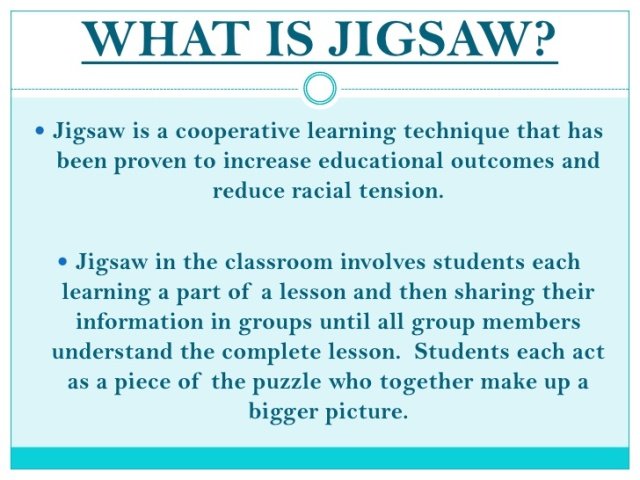For teachers, like us, the word "Jigsaw" is very familiar. I dare to say that every teacher who has good teaching literacy must have applied a Jigsaw technique in his class. Jigsaw is one of the learning techniques that are integrated into the cooperative learning model. Currently, the Jigsaw teachnique is widely applied by teachers to help students learn collaboratively and independently. This learning technique focuses on student-centered learning. The learning context of this teachnique also emphasizes on how students learn, not how students are taught.
The main purpose of applying Jigsaw technique is to improve students' mastery and understanding through structured and guided learning. Some aspects of Jigsaw such as teamwork, individual and group responsibility, and the formation of heterogeneous learning group members play important roles in student learning success.
Furthermore, while running this learning technique, the teacher must form two types of groups. The first is called the core group and the second is called the expert group. The core group is a group of 4-5 students with gender diversity, ability level and background. While the expert group is a group consisting of students who come from different core groups with the same topic discussed.
To better understand how students learn by using the Jigsaw technique, I will describe the steps to apply this learning technique:
After starting the class, the teacher forms several core groups. Each group consists of 4-6 students. Group members must be heterogeneous, each group having different gender, different levels of ability and race.
The teacher determines several topics, and passes them on to the students to be understood through discussion. Each group receives the same topic, and each group member must understand different sub-topics.
After they receive sub-topics, students form an expert group based on the same sub-topic, for example, Students from groups A, B, C, D who have sub-topics about X form a group of experts called Group X. At this stage, the teacher sets the time limit for them for discussion.
After they complete the discussion, the teacher asks the students to return to the core group. Each student in the core group presents his / her peers about the sub-topics they discuss while in the group of experts in turn. Other students listen and make summaries, and they are encouraged to ask questions to those who are presenting in their group.
After the presentation session is over, the teacher asks each group to send a group representative to present a summary of the discussion in front of the class.
At the end of the session, the teacher performs an individual written test. Each student score is calculated with their group members to get the average score from each group. The group with the highest score is named the best group and awarded.
In conclusion, based on the explanation of the above steps we can know that students learn collaboratively and independently. Such this learning technique is worthy to apply by teachers who believe that students are more likely to learn through discussion and interaction with their peers. The role of teachers in learning is minimized, where teachers only act as facilitators and mentors.
References
(a teacher and writer)@affiedalfayed
TO SUPPORT EDUCATIONAL CONTENTS AND RESOURCESUSE #steemiteducation TAG




Awesome work, I love the jigsaw technique in class too. It works and it gets everyone involved too
Your class must be interesting.
basically it is a good technique to break the tension between subgroups in the classroom.
I like it!
The puzzle technique encourages integration, I like how you proposed it. The best strategies to better results will be obtained.
Thank you. I am glad to hear it
I have applied it for the introduction of esters in chemistry. Worked one time ok and one time great.
Great post, keep it up.